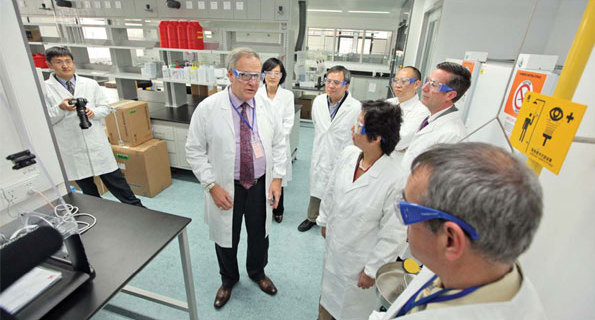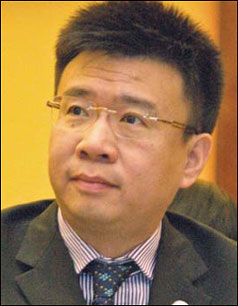Alliance fights a modern scourge
Updated: 2013-03-22 07:32
By Zhong Nan (China Daily)
|
||||||||
|
Scientists at Eli Lilly and Company are looking to produce more generic medicines for treating and controling diabetes. Zhong Nan / China Daily |
US drug major Eli Lilly looks to make big strides in China's diabetic medicine market
Like other global pharmaceutical firms, Eli Lilly and Company is betting big on China, but with a difference.
Unlike most of the other drug companies, the US firm is looking to be a key player in the $2.2 billion (1.7 billion euros) Chinese diabetic medicine market with new drugs and strategic alliances with domestic pharmaceutical companies.
Though insulin is still the mainstay of the Chinese diabetic care market, Lilly expects to add more generic medicines for treatment and control of diabetes in the next few years.
Currently, more than 366 million people worldwide suffer from diabetes, which is incurable, with the number of people affected climbing to over 92 million in China last year. China has the largest number of diabetics in the world, and the number is expected to swell to 96 million by the end of this year, says a report published by the International Diabetes Federation last year.
"We will expand our manufacturing capabilities, set up more research and development centers and partner local hospitals and institutes," says Gu Bin, vice-president of Lilly China.
The US company, which set up its first China research and development center in Shanghai last year, now has more than 100 scientists engaged in diabetes care researching products that are specific to the Chinese market. Lilly set up a second manufacturing unit in China in Suzhou last year. The $64 million plant makes non-Cephalosporin products and has enough surplus capacity to cater to the company's insulin expansion plans.
"Growth in China is critical for Lilly, as the patents for several drugs will expire in the US and European markets in the next few years," Gu says.
|
Gu Bin is vice-president of Lilly China. |
"China and the other emerging markets along with Japan and the animal health business are the counter-cyclical growth engines for Lilly."
The US company has enjoyed growth in excess of 25 percent since 2008, and is looking to add more high-end patented drugs and insulin, along with affordable generic drugs.
To add impetus to its China plans, Lilly set up a global IT innovation center in Dalian, Liaoning province, this month. The laboratory is expected to be critical to Lilly's global business operations.
In addition the company has also made venture capital investments of over $87 million to foster innovation in the Chinese pharmaceutical sector. The company employs more than 4,000 people in China-in Beijing, Shanghai and Suzhou.
Gu says changing lifestyles in China have contributed to a sharp rise in the number of people suffering from diabetes. The Chinese diabetes care market is expected to be worth $2.8 billion by 2015, compared with $642 million in 2009, a recent research report says.
"Diabetes care is part of the priority areas identified by the Chinese government for additional spending in the next few years," Gu says.
What makes Lilly's diabetes products unique, he says, is that the genetic and dietary differences between Chinese people and people from other countries are taken into account.
The company has also formed an alliance with Novast Laboratories Ltd, a generic and specialty pharmaceutical company in Nantong, Jiangsu Province, to expand its manufacturing capabilities for diabetes care products in China.
"We are quite confident in further expanding our collaboration with Novast. We expect to develop a platform of high-quality Lilly branded generic medicines in China in line with the current 12 Five-Year Plan (2011-15) and medical reforms, both of which call for significant improvements in the quality of medicines in the pharmaceutical industry," Gu says.
With China becoming more affluent, living habits normally associated with type II diabetes, such as being overweight, exercising less, rich diets and sugary drinks, have become more common.
"As China's large demographic of elderly people grow older, dependence on cars increases, work pressure grows and people get less sleep, there is bound to be an increase in the number of diabetes patients. There will also be an increase in the demand for drugs to battle diabetes," says Mu Yiming, chief physician of the department of endocrinology at General Hospital of the Chinese People's Liberation Army.
"Diabetes is a public health problem. Proper treatment along with the lifestyle changes can help patients tackle the disease. Diabetes care involves many aspects of the health system, including prevention, early detection, treatment and prevention of complications. So it is important to develop a life-long model to tackle it, he says.
Gu says Lilly will concentrate on spreading awareness about diabetes in China and educate people on the need to give up unhealthy living habits and practice a healthy routine.
zhongnan@chinadaily.com.cn
(China Daily 03/22/2013 page16)

 Li Na on Time cover, makes influential 100 list
Li Na on Time cover, makes influential 100 list
 FBI releases photos of 2 Boston bombings suspects
FBI releases photos of 2 Boston bombings suspects
 World's wackiest hairstyles
World's wackiest hairstyles
 Sandstorms strike Northwest China
Sandstorms strike Northwest China
 Never-seen photos of Madonna on display
Never-seen photos of Madonna on display
 H7N9 outbreak linked to waterfowl migration
H7N9 outbreak linked to waterfowl migration
 Dozens feared dead in Texas plant blast
Dozens feared dead in Texas plant blast
 Venezuelan court rules out manual votes counting
Venezuelan court rules out manual votes counting
Most Viewed
Editor's Picks

|

|

|

|

|

|
Today's Top News
Boston bombing suspect reported cornered on boat
7.0-magnitude quake hits Sichuan
Cross-talk artist helps to spread the word
'Green' awareness levels drop in Beijing
Palace Museum spruces up
First couple on Time's list of most influential
H7N9 flu transmission studied
Trading channels 'need to broaden'
US Weekly

|

|









